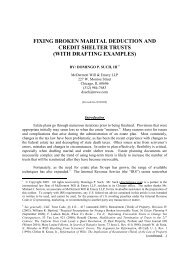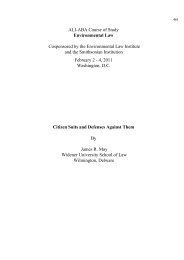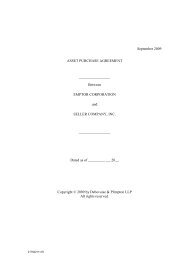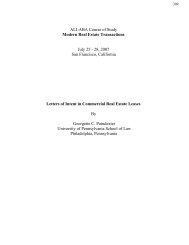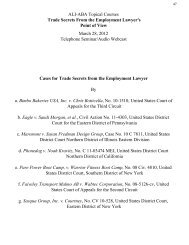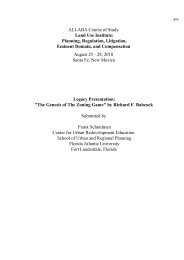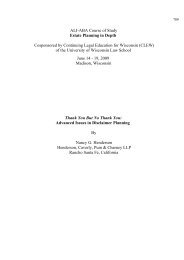ALI-ABA Topical Courses Trademark Law: What's New ... - ALI CLE
ALI-ABA Topical Courses Trademark Law: What's New ... - ALI CLE
ALI-ABA Topical Courses Trademark Law: What's New ... - ALI CLE
You also want an ePaper? Increase the reach of your titles
YUMPU automatically turns print PDFs into web optimized ePapers that Google loves.
8Plaintiff alleged that EA violated California statutory and common law right of publicity.California’s right of publicity statute provides, “Any person who knowingly uses another’sname, voice, signature, photograph, or likeness, in any manner, on or in products,merchandise, or goods, or for purposes of advertising or selling, or soliciting purchases of,products, merchandise, goods or services, without such person’s prior consent . . . shall beliable for any damages sustained by the person or persons injured as a result thereof.” Cal.Civ. Code § 3344(a). According to the court, the statutory right of publicity complements thecommon law right of publicity, which arises from the misappropriation tort derived from thelaw of privacy. To state a claim under California common law, a plaintiff must allege “‘(1)the defendant’s use of the plaintiff’s identity; (2) the appropriation of plaintiff’s name orlikeness to defendant’s advantage, commercially or otherwise; (3) lack of consent; and (4)resulting injury.’” Hilton v. Hallmark Cards, 580 F.3d 874 (9th Cir. 2009) (quoting Downingv. Abercrombie & Fitch, 265 F.3d 994 (9th Cir. 2001)).EA argued that plaintiff’s California right of publicity claims are barred by the FirstAmendment and California law. The court rejected these arguments and denied EA’s motionto dismiss the California right of publicity claims.The court explained that a defendant may raise an affirmative defense that the challengedwork is “protected by the First Amendment inasmuch as it contains significanttransformative elements or that the value of the work does not derive primarily from thecelebrity’s fame” citing Hilton, 580 F.3d at 889. The court discussed Comedy III Prods., Inc.v. Saderup, 25 Cal. 4th 387 (2001), in which the California Supreme Court held thatdefendant’s “literal, conventional depictions of The Three Stooges,” drawn in charcoal andprinted on tee-shirts, did not contain transformative elements that warranted protection bythe First Amendment, and Winter v. DC Comics, 30 Cal. 4th 881 (2003), in which the samecourt held that a comic book depiction of Johnny and Edgar Winter as half-human, halfwormcartoon characters was sufficiently transformative.In this case, the court held that EA’s depiction of plaintiff in “NCAA Football” is notsufficiently transformative to bar his California right of publicity claims as a matter of law.“In the game, the quarterback for Arizona State University shares many of plaintiff’scharacteristics. For example, the virtual player wears the same jersey number, is the sameheight and weight and hails from the same state. EA’s depiction of plaintiff is far from thetransmogrification of the Winter brothers. EA does not depict plaintiff in a different form;he is represented as he what he was: the starting quarterback for Arizona State University[and] the game’s setting is identical to where the public found plaintiff during his collegiatecareer: on the football field.” The court also rejected EA’s argument that the court shouldconsider the transformative elements of the video game as a whole, noting that such a viewis not supported by precedent, and stating that the court’s focus must be on the depiction ofthe plaintiff, not the game’s other elements.The court then addressed EA’s public interest defense. According to the court, underCalifornia law no cause of action will lie for the publication of matters in the public interest.The court distinguished this case from Gionfriddo v. Major League Baseball, 94 Cal. App.4th 400 (2001),where the court held that the defendants, who operated a website that




